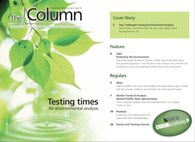Meat on your bones
A study published in the Journal of Separation Science has looked at using the racemization of amino acids as a proxy for DNA preservation, giving archaeologists a rapid screening method for samples too badly damaged to extract.

Using PCR to amplify the DNA of long dead specimens can provide researchers and archaeologists with a wealth of information about the subjects. However, the process is not always straightforward; the DNA decays, often leaving so little behind that study becomes impossible. A study published in the Journal of Separation Science has looked at using the racemization of amino acids as a proxy for DNA preservation,1 giving archaeologists a rapid screening method for samples too badly damaged to extract.
Amino acids in living species exist mostly in L-form, rather than D-form, with enzymes working to maintain this dominance. Upon death the enzymes stop working and the amino acids racemize to D-form. This process is influenced by many of the same factors that affect DNA decay, so the researchers developed a method to use HPLC to determine the D/L ratio of certain amino acids.
The method was applied to bones recovered from seven mummies and treated with hydrochloric acids to remove any proteins from external sources. It revealed a D/L ratio less than 0.1, indicating sufficient DNA for extraction and PCR amplification. As the pre-treatment, extraction and analysis only took a few minutes each, the study concludes that the method represents a fast and inexpensive way to examine the state of DNA in old bones and could find use in the archaeological community.
P. Iuliani et al., J. Sep. Sci.,, 33(16), 2411–2416 (2010).
This story originally appeared in The Column. Click here to view that issue.
Troubleshooting Everywhere! An Assortment of Topics from Pittcon 2025
April 5th 2025In this installment of “LC Troubleshooting,” Dwight Stoll touches on highlights from Pittcon 2025 talks, as well as troubleshooting advice distilled from a lifetime of work in separation science by LCGC Award winner Christopher Pohl.












